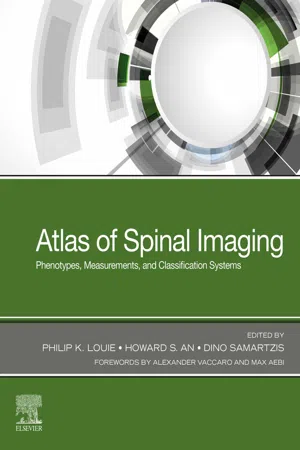
Atlas of Spinal Imaging Phenotypes
Phenotypes, Measurements and Classification Systems
Philip Louie, Howard S. An, Dino Samartzis
- 282 pages
- English
- ePUB (mobile friendly)
- Available on iOS & Android
Atlas of Spinal Imaging Phenotypes
Phenotypes, Measurements and Classification Systems
Philip Louie, Howard S. An, Dino Samartzis
About This Book
Spine-related pain is the world's leading disabling condition, affecting every population and a frequent reason for seeking medical consultation and obtaining imaging studies. Numerous spinal phenotypes (observations/traits) and their respective measurements performed on various spine imaging have been shown to directly correlate and predict clinical outcomes.Atlas of Spinal Imaging Phenotypes: Classifications and Radiographic Measurementsis a comprehensive visual resource that highlights various spinal phenotypes on imaging, describes their clinical and pathophysiological relevance, and discusses and illustrates their respective measurement techniques and classifications.
-
Helps readers better understanding spinal phenotypes and their imaging, and how today's knowledge will facilitate new targeted drug discovery, novel diagnostics and biomarker discovery, and outcome predictions.
-
Features step-by-step instructions on performing the radiographic measurements with examples of normal and pathologic images to demonstrate the various presentations.
-
Presents clinical correlation of the phenotypes as well as the radiographic measurements with landmark references.
-
Includes validated classification systems that complement the phenotypes and radiographic measurements.
-
Complies the knowledge and expertise of Dr. DinoSamartzis, thepreeminentglobal authority on spinal phenotypes who has discovered and proposed new phenotypes and classificationschemes;Dr. Howard S. An, a leading expert in patient management and at the forefront of 3D imaging of various spinal phenotypes; and Dr. Philip Louie, a prolific surgeon who is involved in one of the largest machine learning initiatives of spinal phenotyping.
Frequently asked questions
Information
Chapter 1: Introduction
b Department of Orthopedic Surgery, Rush University Medical Center, Chicago, IL, United States
c International Spine Research and Innovation Initiative (ISRII), Rush University Medical Center, Chicago, IL, United States